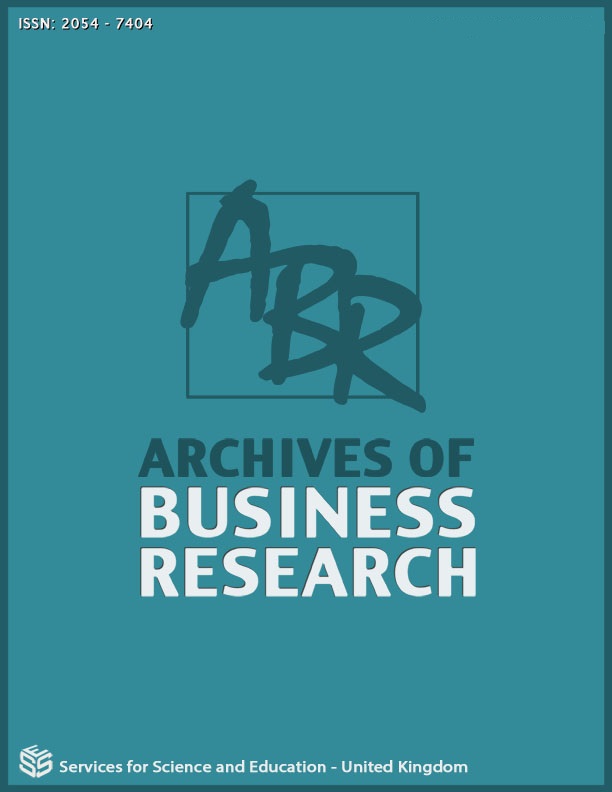A path analysis on the strategic determinants of the average revenue per user in the Saudi telecom sector
DOI:
https://doi.org/10.14738/abr.94.9991Keywords:
SEM, Hierarchical Regression, ARPU, The Rules of Casual OrderAbstract
This study compared a restructured hierarchical regression using structural equation modeling (SEM) with a path analysis SEM Regression using The Rules of Casual Order. The dataset originated from Jones & Alshammari (2017) which studied the Value-Added Intellectual Coefficient (VAIC) determinants and capital expenditures (CAPEX) effects on the average revenue per user (ARPU). The comparisons showed CLE and CEEcap explained 61% of ARPU. For every 1 unit of change in CLE and CEEcap combined, produces 2 units of change in ARPU. The results on HCEcap and SCEcap were inconsistent, regression weights were insignificant at the p ≤ .001 level, and both determinants did not correlate with Revenue. This study showed that causation can be established prior to any multivariate or SEM statistical procedures. The rules of casual order are an effective way of designing a model based on reality and show the true effects among observed variables.
References
Bryman, A., & Cramer, D. (2011). Quantitative Data Analysis with IBM SPSS 17, 18, & 19: A Guide for Social Scientist. Routledge.
Davis, J. A. (1985). The logic of casual order (M. S. Lewis-Beck (ed.); 55th ed.). SAGE.
Drucker, P. F. (2008). Management (J. Marciariello (ed.); Revised). HarperCollins.
Financial Accounting Standards Board. (1998). Statement of Position 98 - 1 Accounting for the Costs of Computer Software. http://www.fasb.org/jsp/FASB/Document_C/DocumentPage?cid=1176156442651&acceptedDisclaimer=true
Hair, Joseph F., Anderson, Rolph E., Tatham, Ronald L., Black, W. C. (1998). Multivariate Data Analysis (5th ed.). Prentice-Hall Inc.
Iazzolino, G., & Laise, D. (2013). Value added intellectual coefficient (VAIC): A methodological and critical review. Journal of Intellectual Capital, 14(4), 547–563. https://doi.org/10.1108/JIC-12-2012-0107
Jones, A., & Alshammari, H. (2017). Measuring Knowledge Workers’ Productivity in the Kingdom of Saudi Arabia Telecom Industry. Archives of Business Research, 5(10), 20. https://doi.org/10.14738/abr.510.3786
Jones, A. H. (2018). Lessons learned from a business owners’s risk assessment of capitalized internal software development projects. ELK Asia Pacific Journal of Project Management and Control, 5(1), 1–34. https://www.elkjournals.com/project-management-and-control.asp
Kaplan, R. S., & Norton, D. P. (2008). The EXECUTION PREMIUM: Linking Strategy to Operations for Competitive Advantage. Harvard Business School Publishing. permissions@hbsp.harvard.edu
Kline, R. B. (2016). Principles and Practice of Structural Equation Modeling (D. A. Kenny (ed.); 4th ed.). The Guilford Press.
Porter, M. E. (1985). COMPETITVE ADVANTAGE: Creating and Sustaining Superior Performance (First Free). The Free Press.
Pulic, A. (2004). Intellectual capital--does it create or destroy value ? Measuring Business Excellence, 8(1), 62–68. https://doi.org/10.1108/13683040410524757
Schumacker, Randall E; Lomax, R. G. (2004). A Beginner’s Guide to STRUCTURAL EQUATION MODELING (2nd ed.). Psychology Press.
Stahle, P., Stahle, S., & Aho, S. (2011). Value added intellectual coefficient ( VAIC ): a critical analysis. Journal of Intellectual Capital, 12(4), 531–551. https://doi.org/10.1108/14691931111181715
Stordahl, K., & Elnegaard, N. K. (2007). Adoption rate forecasts and rollout strategies. In NETNOMICS: Economic Research and Electronic Networking (Vol. 8, Issues 1–2, pp. 153–170). https://doi.org/10.1007/s11066-008-9014-1
Turulja, L., & Bajgoric, N. (2020). COMPARISON OF STRUCTURAL EQUATION MODELLING AND MULTIPLE REGRESSION TECHNIQUES FOR MODERATION AND MEDIATION EFFECT ANALYSIS. Sarajevo Business and Economics Review, 38, 29–50.






